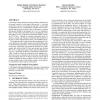Free Online Productivity Tools
i2Speak
i2Symbol
i2OCR
iTex2Img
iWeb2Print
iWeb2Shot
i2Type
iPdf2Split
iPdf2Merge
i2Bopomofo
i2Arabic
i2Style
i2Image
i2PDF
iLatex2Rtf
Sci2ools
101
click to vote
SIGMETRICS
2003
ACM
2003
ACM
An empirical evaluation of wide-area internet bottlenecks
Conventional wisdom has been that the performance limitations in the current Internet lie at the edges of the network – i.e last mile connectivity to users, or access links of stub ASes. As these links are upgraded, however, it is important to consider where new bottlenecks and hot-spots are likely to arise. In this paper, we address this question through an investigation of non-access bottlenecks. These are links within carrier ISPs or between neighboring carriers that could potentially constrain the bandwidth available to longlived TCP flows. Through an extensive measurement study, we discover, classify, and characterize bottleneck links (primarily in the U.S.) in terms of their location, latency, and available capacity. We find that about 50% of the Internet paths explored have a nonaccess bottleneck with available capacity less than 50 Mbps, many of which limit the performance of well-connected nodes on the Internet today. Surprisingly, the bottlenecks identified are roughly ...
Related Content
| Added | 05 Jul 2010 |
| Updated | 05 Jul 2010 |
| Type | Conference |
| Year | 2003 |
| Where | SIGMETRICS |
| Authors | Aditya Akella, Srinivasan Seshan, Anees Shaikh |
Comments (0)

